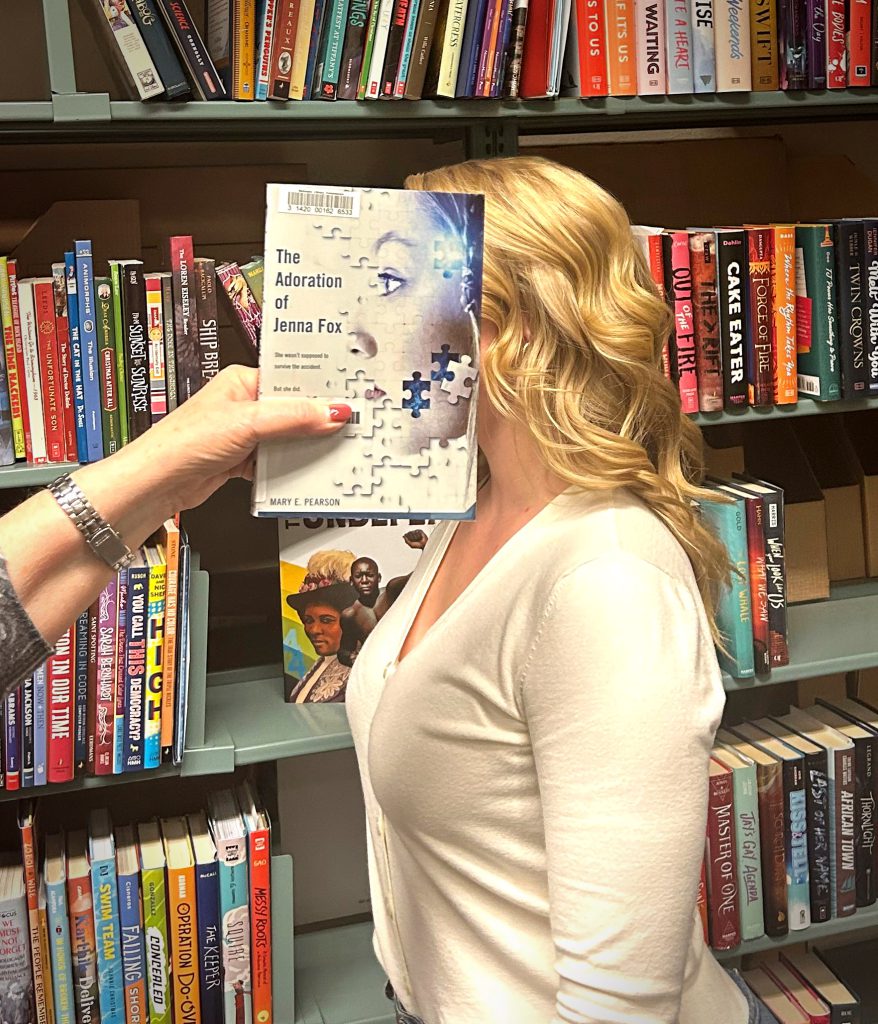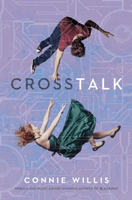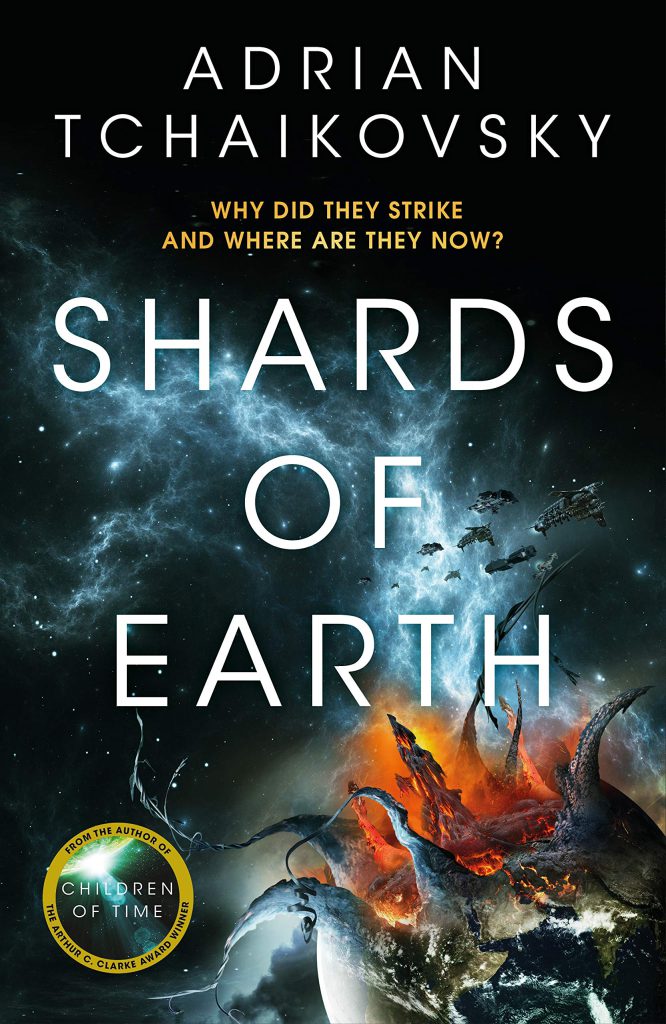Search the Blog
Categories
- Books & Reading
- Broadband Buzz
- Census
- Education & Training
- Friday Reads
- General
- Grants
- Information Resources
- Library Management
- Nebraska Center for the Book
- Nebraska Libraries on the Web
- Nebraska Memories
- Now hiring @ your library
- Preservation
- Pretty Sweet Tech
- Programming
- Public Library Boards of Trustees
- Public Relations
- Talking Book & Braille Service (TBBS)
- Technology
- Uncategorized
- What's Up Doc / Govdocs
- Youth Services
Archives
Subscribe
Tag Archives: Science Fiction
Friday Reads, The Oxygen Farmer, by Colin Holmes
The Oxygen Farmer by Colin Holmes is set in the near future, where the Moon has a station with gravity, and a Mars expedition is being prepared in the moon’s orbit. An astronaut, Mil (Millennium) Harrison, nearing 80 is an oxygen farmer, creating oxygen for the habitat, and the Mars mission. On a delivery, his transportation, a “spider truck” breaks down, and after discovering help is many hours away, decides to take a short cut home, to pick up the part he needs. He goes through a part of an “exclusion zone”, where people aren’t supposed to go, although he has no idea why. It’s not historic, like the others. While there, he finds a hidden, underground base, which is radioactive. He scrambles out, and heads home. Of course, he has to report it. Eventually. Being a solitary, crotchety, legend, even he has to follow the rules. He helped write them, after all.
His discovery sets in motion so many events. The long-buried secret on the moon shouldn’t exist. His granddaughter first slated for the Mars mission, is sidetracked to the moon, for helping him do research on it. When he’s sent to Earth for therapy an attempt is made on his life. A second occurs on the moon, in a far more secure environment, with the loss of a shuttle, and all aboard.
It’s a really good read, and while there is tech, it’s not tech heavy. Mil is a surprising choice for the hero, and his family, and girlfriend, a dr.; all the women’s characters are well done. The plot moves quickly. The family dynamics and history are also interesting, adding depth to what could have been a hard science only adventure. While there are a few moments that are predictable, especially if you’ve read a lot of intrigue/spy type books, there’s a lot here that’s interesting, and kept me reading.
The Oxygen Farmer, Colin Holmes, ISBN 9780744306675, Camcat Publishing,
Friday Reads, Mickey 7, by Edward Ashton
Mickey 7 by Edward Ashton is hard science fiction set in the far future. Mickey Barnes was born on a colony world where the hardest part of settling the colony is over. The planet is terraformed, and it’s safe to live there. Life is nearly ideal, except Mickey has no scientific or technical talents; he’s a historian on a world where everything can be looked up online. He does get a subsistence pay, but he’s gotten into deep debt, and needs to get off the planet, and there’s only one way off—the colony ship that’s been put together at great expense to the colony. Everything is weighed to the last milligram, and even the colonists pared down belongings aren’t allowed on, at the last minute. And his only way on is to become an “expendable.” The one member of the new colony that can die and be printed from a vat, with his mind transferred. You see, on the trip, and in the settlement, the robots they have can’t be replaced, but the expendable can. Plus, they have found, that the human body takes longer to shut down in adverse situations, like intense heat or radiation, than the electronic bots.
The story starts in real time stream, starting with Mickey 7, on the new colony world, an ice planet, falling down a crevice, and getting slightly (for him) injured. His air cover won’t come to help him, for fear of the creepers, the local life forms. He’s too deep to be rescued, but is rescued by a huge creeper, and set outside tunnels running under the planet’s surface. This is the source of the latest problem, when the air cover flyer got back to the settlement, he reported Mickey dead, so number 8 was printed. And Mickey 7 returned. The colony can’t support one more person, but neither want to die. There is a taboo about having more than one duplicate existing at a time. The explanation of the taboo, Mikey’s multiple deaths, and research into how other colonies have begun are the rest of the story. The author handles several heavy themes quickly, with humor. Where do you go for privacy, in a colony with just public spaces, with only under 200 people, when you can’t be in your room? Not being seen by the same people in overlapping times is much more difficult than one would suppose, and Mickey 8 is far less concerned about dying, that Mickey 7.
And then there are the creepers. When the planet was surveyed, it was done from their home planet. Since no industry was detected, and it seemed to have enough oxygen, and was just in the “Goldilocks zone” for life, it was thought habitable. When they got there, it was covered in ice, with unbreathable air. The creepers showed up, and seemed to be mere animals. However, Mickey discovers that their tunnels are evenly spaced at one hub. He has had a sneaking feeling for a while that they may be sentient. Which is just another of Mickey 7’s problems—to report, or not report. Especially since he believes, the leader of the expedition will not only end his life, but the indigenous life forms, too. So, of course, it gets much more complicated from there.
An interesting, and surprisingly funny stand alone, with some deep thinking hidden inside.
Mickey 7, by Edward Ashton, hardback, St. Martin’s Press, ISBN 978-1-250-27503-6, 27.99.
#BookFaceFriday “The Adoration of Jenna Fox” by Mary E. Pearson
Don’t fall to pieces, it’s #BookFaceFriday!

Who’s that girl? We all adore a good mystery, and this week’s #BookFace, “The Adoration of Jenna Fox” by Mary Pearson (Square Fish, 2009) will pull you right in!
The first book in the The Jenna Fox Chronicles, it is a brand new addition to the Book Club Collection. We love it when book clubs and libraries donate their book sets to us after they’re done reading, making them available to all the other book clubs across the state. Thanks to John A. Stahl Library in West Point, we have eight copies of this title available as your next book club read. You can also find it in Audiobook format in Nebraska OverDrive Libraries collection.“This is a beautiful blend of science fiction, medical thriller, and teen-relationship novel that melds into a seamless whole that will please fans of all three genres.”
— Library Journal, starred review
Book Club Kits Rules for Use
- These kits can be checked out by the librarians of Nebraska libraries and media centers.
- Circulation times are flexible and will be based upon availability. There is no standard check-out time for book club kits.
- Please search the collection to select items you wish to borrow and use the REQUEST THIS KIT icon to borrow items.
- Contact the Information Desk at the Library Commission if you have any questions: by phone: 800/307-2665, or by email: Information Services Team
Love this #BookFace & reading? Check out our past #BookFaceFriday photos on the Nebraska Library Commission’s Facebook page!
Posted in Books & Reading, General
Tagged Book Club Kits, bookfacefriday, Mary Pearson, mystery, Novel, Reading, Science Fiction, The Adoration of Jenna Fox, Thriller, YA books
1 Comment
Friday Reads: Shards of Earth, by Adrian Tchaikovsky
Shards of Earth, by Adrian Tchaikovsky, is science fiction, by a British science fiction and fantasy master. The characters are engaging, human, (and intriguing when not human.) The idea of an alien which is moon sized that can travel faster than light, each a single being, called the Architects, is remarkable. That it’s an absolute killing machine pointed at all inhabited worlds pulls the fractured colonies of Earth and all the known aliens into war against it. The story is not about the war as much as about the final secret weapon that made victory possible. And what happens to that weapon after the war. This only makes sense in that the weapons that win the war are called Intermediaries (Ints), and are humans, medically and chemically modified to be able to mentally contact the Architects. Idris Telemmier is one of the few remaining original class of Intermediaries. He is a war hero. Due to his modifications, he hasn’t aged since the end of the war fifty years ago. Intermediaries can contact Architects, and they can pilot deep space craft through unspace, without having to sleep during the process.
Unspace, unlike some forms of faster than light travel, must be experienced by most sentient beings asleep. If they are awake, they are immediately isolated from other travelers on the ship in unspace. Not only of being alone, but also of being alone with a hostile, unspeakable being that they can’t see, only sense. Most ships travel old routes mechanically, with the pilot being the first to wake, but Intermediary pilots go through unspace awake. They can plot new paths to objects, making Idris especially valuable to his crew on the Vulture God, a salvage ship.
An old war acquaintance of his, Myrmidon Solace, is tasked with contacting Idris on the ship he currently pilots. Solace is from a genetically engineered, and vat grown race of human women warriors who live on their ships, and they are known as the Parthenon. They do not have Intermediaries. Hugh (Council of Human Interests), the governing body of the colonies controls the program, and licenses them. Hugh won’t license any to the Parthenon in the post war era.
Making Intermediaries is an uncertain business. Idris, being first generation, is even more unusual, since he hasn’t aged, and can’t sleep. He’s one of two or three surviving from that first generation. He’s content to work on the salvage ship. The trouble starts with a shore leave where a rich man decides to confiscate him, since later Ints are licensed and conditioned with a “leash” contract (making them more like property.). That doesn’t pertain to Idris. His crew, with Solace, manage to get him off planet, but the job they pick up next only multiplies their troubles—it’s a modern salvage that has the distinctive, destructive design of an Architect kill. Except the war ended fifty years ago, with the disappearance of the Architects, and no one has seen one since.
While some reviewers compare the story to Star Wars and Star Trek, there is a lot more here, and a far more patched up universe. The characters are interesting, the main ones are three-dimensional, and the world building is complex, with more than one political system. One of the characters is Oliana (Olli) Timo, a woman who’s colony found all human life precious, even a child with stunted arms, part of one leg and no sense of her own body—since the age of thee she had become a remote vehicle specialist. And easily one of the strongest, and most physically powerful characters in the story. Which is why she has a very big problem with Solace, a vat grown perfect human. There are more interesting points like these that made the entire story deeper than many of the “space opera” style stories. There’s a colonies’ wide “nationalist” movement to put “humans”, the original type from Earth, first, and that all other types are traitors. Which also has a violent arm. There’s a race no one’s seen, but has lost their planets to the Architects, called Locusts, who use planets to create world ships. There’s an alien mobster and a human aristocrat, who both want to own Idris. And there’s a spy/cop, who is just trying to figure it all out.
With complicated characters, great plotting, and constant action, this is one of the best books I’ve read lately, and I’ve just read the sequel, Eyes of the Void. I’m looking forward to Lords of Uncreation, due out in 2023.
Shards of Earth, The Final Architecture: Book One, by Adrian Tchaikovsky, Orbitbooks.net, Hardback, 2022
British Science Fiction Association (BSFA) award winner for best novel, 2022.
Posted in Books & Reading
Tagged Adrian Tchaikovsky, Fantasy, Friday Reads, Science Fiction, Shards of Earth
Leave a comment
Friday Reads: The Long Way To A Small, Angry Planet by Becky Chambers
Science fiction titles have been popping up more and more in my reading list over this past year, perhaps as an escape from our current reality. A list of the some of the best new science fiction from the last 15 years led me to some fantastic escapes, including:
- Station Eleven by Emily St. John Mandel (2014)
- Lagoon by Nnedi Okorafor (2014)
- The Lesson by Cadwell Turnbull (2019)
- The Three-Body Problem by Cixin Liu (2014)
- The Long Way to a Small, Angry Planet by Becky Chambers (2014)
The last one on that list, The Long Way to a Small, Angry Planet by Becky Chambers is the first in the Wayfarers trilogy. Described as a “light-hearted space opera”, the story follows a ragtag group of wormhole tunnelers as they cruise through space. New ship accountant Rosemary is adjusting to life off-planet and to her new crew mates. But when the team is offered the tunneling job of a lifetime, Rosemary must decide if she can trust them with a secret about her past.
I don’t often associate “cozy” with “sci-fi” but this is an apt descriptor of this novel. Quirky, likeable characters and a heartwarming tone would make this a perfect read for fans of The Hitchhiker’s Guide to the Galaxy.
Chambers, Becky. The Long Way to a Small, Angry Planet. New York: Harper Voyager 2016. (Originally self-published, 2014).
Posted in Books & Reading
Tagged Becky Chambers, Book Review, Friday Reads, Science Fiction, scifi
Leave a comment
Friday Reads: Crosstalk, by Connie Willis

In Crosstalk by Connie Willis, a simple surgery to promote empathy between romantic partners goes hilariously wrong. It shows how constant, complete, personal connection is anything but desirable. Briddey Flannigan should have known, since the cell phone company, (COMMSPAN) she works for in a US city, is very nearly a model of what will come, with gossip seemingly carried on the breezes! And avoiding telling her family the news that she and her perfect boyfriend, Trent Worth will be having the implantation of a devise which will result in empathy,( if they are truly in love), before she tells her friends at work is, well, a lost cause.
The entire novel moves at a breakneck pace from one situation to another. Just as soon as Bridey has settled her family, her boyfriend Trent springs a speeded up surgery schedual on her, so she’s off to the hospital. And avoiding gossip and her family, by hiding her car. After seeing that her family has no boundaries where it comes to Bridey’s privacy one begins to see why she’s so secretive. And why she settles on the up and coming executive Mr. Worth, and his push to get the EED (the empathy device) before they marry. Which her family and CB Schwarz think is a really bad idea–and they all email, call, or text her. She argues it’s been tested before, and that even celebrities have had it done, and that they are even having the Dr. who invented the device doing the surgery. The surgery goes well. The aftereffects are, well, telepathy. And of course, the first person she hears is not Trent, but CB Schwarz, who is naturally telepathic.
Ms. Willis brings the claustrophobic and confusing experience that we imagine to be telepathy to a print page well. It can be confusing for the reader as well, but having a sense of the harried life of Briddey, makes it worth a little push just to get through those passages. It also gives her new relationship with CB a understandably difficult start. And exposes the real reasons behind Trent’s wanting to get the EED before getting married, like other couples.
This is the perfect introduction to Connie Willis and her comic timing, her patter, and infectious humor and sense of irony. If you enjoy Crosstalk, you’ll enjoy, To Say Nothing About the Dog, and Bellwether.
Crosstalk, by Connie Willis, Del Rey, 978-0-34554067-6
Posted in Books & Reading
Tagged Connie Willis, Crosstalk, Friday Reads, Rom-Com, Science Fiction, Telepathy, too-connected society?
Leave a comment
Friday Reads; Sea of Rust, by C. Robert Cargill

Sea of Rust
Not your ordinary chase adventure, shoot-’em-up, Science Fiction dystopia–Sea of Rust, by C. Robert Cargill, begins after the robot revolution, when man is gone. After the assimilation started by OWIs (One World Intelligences), which once were supercomputers that now share their consciousness with millions of individual workers called “facets”. The individual, autonomous AIs (robots) either give up, are destroyed, or escape and establish their own societies in other cities. This cycle continues until all that are left are groups in the Midwest Rust Belt, dug into new fortifications or old cities. The Midwest Rust Belt has become the Sea of Rust where robots go to die. Or a place they are sent when they go mad.
Brittle goes out into the sea to scavenge for parts for other robots, and for exchange for her own. Not a safe job. Her latest is very nearly her last. She is a rare model, and another robot, which is the same model, needs parts that only she has and she needs the parts to function. And so the running (& shooting & explosions) begins.
Many of the scenes in the Sea of Rust are horrific, and the tone is often dark. The OWIs and robots deal with the HuPop (Human Population) efficiently and ruthlessly. However, the way they do it does leave unseen damage in their personalities and on their reputations. Yes, despite being machines they do have emotions, sometime in spite of their programing. They also destroy nearly all biological life on the planet in the process of eliminating man. In eliminating humanity, many of the smaller, independent AIs discovers that they’ve eliminated their reason for existing. I was intrigued by how they became more human, showing fear of incorporation into a mainframe, or even fear of another robot’s reputation from the war.
I think you’ll find this a very thought-provoking read, very well written. This is not a young adult book. I haven’t read Robopocalipse, by Daniel H. Wilson, but I believe it would be a good contrasting read. (Yes, it’s on my to-read list!)
Before anyone brings up Asimov’s “Three Rules for Robotics”, you’ll have to read the story to see how well they hold up in Cargill’s universe.
Sea of Rust by C. Robert Cargill, Harper Voyager, an Imprint of Harper Colins Publishers, hardback 9780062405838
Posted in Books & Reading, Uncategorized
Tagged C. Robert Cargill, dytopia, Friday Reads, robots, Science Fiction
Leave a comment
Hugo Award Finalists Announced
The Hugos are awarded for excellence in the field of science  fiction and fantasy. This year’s finalists for Best Novel are:
fiction and fantasy. This year’s finalists for Best Novel are:
- Ancillary Justice, by Ann Leckie
- Neptune’s Brood, by Charles Stross
- Parasite, by Mira Grant
- Warbound, Book III of the Grimnoir Chronicles, by Larry Correia
- The Wheel of Time, by Robert Jordan and Brandon Sanderson
Finalists in other categories are available at the Hugo Awards Site. The Hugo Awards are voted on by members of the World Science Fiction Convention (“Worldcon“), who are fans. The Awards will be presented at Loncon 3, on August 17, 2014.
The Hugo is one of the major U.S. awards for SF&F: the other is the Nebula, voted on, and presented by active members of Science Fiction and Fantasy Writers of America in May. The 2013 Nebula Nominees for Best Novel are:
- We Are All Completely Beside Ourselves, by Karen Joy Fowler
- The Ocean at the End of the Lane, by Neil Gaiman
- Fire with Fire, by Charles E. Gannon
- Hild, by Nicola Griffith
- Ancillary Justice, by Ann Leckie
- The Red: First Light, by Linda Nagata
- A Stranger in Olondria, by Sofia Samatar
- The Golem and the Jinni, by Helene Wecker.





